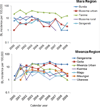Incidence and trends in Burkitt lymphoma in northern Tanzania from 2000 to 2009
- PMID: 22618958
- PMCID: PMC3427713
- DOI: 10.1002/pbc.24194
Incidence and trends in Burkitt lymphoma in northern Tanzania from 2000 to 2009
Abstract
Introduction: Burkitt lymphoma (BL) is endemic in parts of Tanzania, but there is scant country or region level data about burden and trends of BL in Tanzania over the past three decades. Here, we update baseline epidemiology of BL in northern Tanzania using recent data.
Procedure: Data for childhood BL diagnosed at six hospitals in Mara and Mwanza regions in northern Tanzania during 2000-2009 were compiled. Age, sex, and regional patterns were analyzed. Crude incidence rates of BL were calculated by sex, anatomic site, geographical region, and calendar year.
Results: Among 944 cases, 549 (58%) were male (male/female case ratio 1.4:1). Among those with known anatomic site (92%), facial only tumors represented a large proportion of tumors in boys than girls (50% vs. 36%, P < 0.002). Tumors occurred at a younger mean age in boys than girls (6.8 years vs. 7.6 years, P < 0.01). Crude BL incidence was 4.2 per 100,000, but varied by region (3.0 in Mwanza vs. 6.8 in Mara, P = 0.01), by district (1.4-22), by gender (5.0 in boys vs. 4.0 in girls), and by age group (2.0 in 0-4, 7.8 in 5-9, and 3.1 in 10-15 years). BL incidence peaked in 2001 and decreased gradually thereafter.
Conclusions: Our results indicate that male sex, young age, and geographical characteristics are risk factors for BL in Tanzania. BL incidence declined with calendar year, but the significance of this finding is uncertain. Well-designed epidemiological studies of BL in Tanzania may shed light on environmental characteristics underlying these patterns.
Copyright © 2012 Wiley Periodicals, Inc.
Conflict of interest statement
Conflict of interest: Nothing to declare.
Figures




References
-
- Carneiro PM, Kalokola FM, Kaaya EE. Paediatric malignancies in Tanzania. East Afr Med J. 1998;75:533–535. - PubMed
-
- Mgaya EM, Kitinya JN. Histopathology of malignant tumours of childhood in Tanzania. East Afr Med J. 2000;77:435–439. - PubMed
-
- Parkin DM, Sitas F, Chirenje M, et al. Part I: Cancer in Indigenous Africans--burden, distribution, and trends. Lancet Oncol. 2008;9:683–692. - PubMed
-
- Morrow RH., Jr Epidemiological evidence for the role of falciparum malaria in the pathogenesis of Burkitt's lymphoma. IARC Sci Publ. 1985:177–186. - PubMed
-
- de-The G, Geser A, Day NE, et al. Epidemiological evidence for causal relationship between Epstein-Barr virus and Burkitt's lymphoma from Ugandan prospective study. Nature. 1978;274:756–761. - PubMed
MeSH terms
Grants and funding
LinkOut - more resources
Full Text Sources
Miscellaneous

